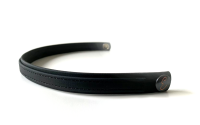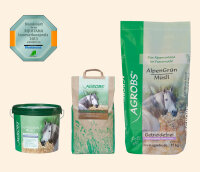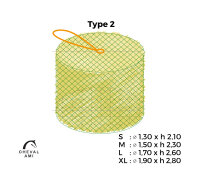Why using a hay net?
- 1. access to hay at any time, without eating too much at once, is important for the health of horses.
For centuries the Steppes were home to generations of wild horses. Here the horses roamed freely eating on average 16 hours a day on whatever fresh or dry grasses and herbs that they could find, according to the season.
We don’t need to be scientists to understand how the horses of those times lived and ate. A steady rhythm of eating and constant movement, normally at a slow pace, an absorption of the necessary nutrients over the whole day. it is these conditions which have made horses physiologically what they are today. Read more about this in our journal.
- 2. to prevent hay from being wasted.
Hay that has fallen to the ground, mixed with mud, litter or excrement is of course no longer eaten. A round bale that is put at free disposal of several horses often wastes around 60% of the hay. With today's hay prices this is no longer possible. A hay net saves working time and money.
Which mesh size should I choose?
For horses that are not yet used to hay nets, it is usually advisable to place a small ration of hay next to the net in order to satisfy the first hunger and thus prevent frustration or excessive plucking of the hay net at the beginning. As a rule, the horses get used to it within a few days.
- The smaller the mesh size, the slower the feed intake.
45mm meshes slow down consumption. After only a few weeks, we have noticed any difference in hay intake between 60mm nets for many horses. These nets ensure above all that no hay is wasted.
- The meshes must be smaller than the hooves.
- The structure of the hay
The finer the texture of the hay, the shorter the stalks, the easier it naturally gets through the net. Coarser hay from long, hard stalks can be plucked through the net somewhat more difficult for horses with mesh sizes below 45 mm. Even if, as is often the case with the large square bales, the hay is extremely heavily compressed, you should not use meshes that are too small.
If the horse has only a few hours access to hay in a net due to some circumstances (e.g. change paddock/box), choose a hay net with larger meshes. If your horse can eat hay around the clock, choose narrower meshes.
The rule is: 1.5 to 2 kg hay per 100 kg body weight per day!
We recommend small meshes.
How does the round bale get into the net?
Place the hay net on the upper half of the hay bale and position it in the middle. Then pull it symmetrically down to about halfway. Remove the string, or the plastic with which the bale was held together and pull the net down to the ground.
Now turn the bale over and close the hay net with the braided cord. It is advisable to carefully weave the remaining long cord into the net so that the horses do not get caught.
Will the gum be damaged by the permanent use of hay nets?
Normally the horses do not gnaw at the nets or hay, but pluck directly at the stalks that protrude from the net. To get the stalks out, they nudge the hay net with their noses, see close-up in the video below this text.
The hay nets of Cheval Ami are braided or woven, depending on the material. We do not have any negative feedback about gum problems. Make sure that the horses are never completely starved.
NOTE: For shod horses, hay nets should only be used in hay harbours.

 German
German French
French




